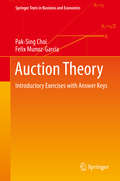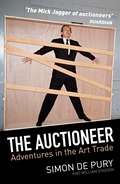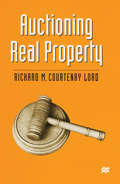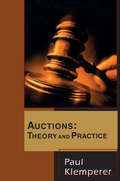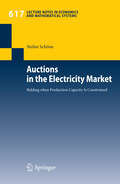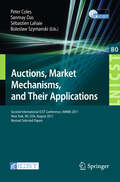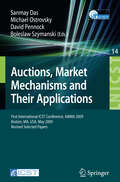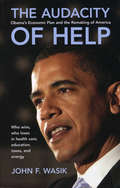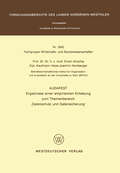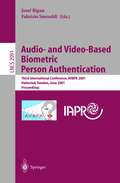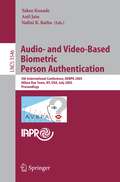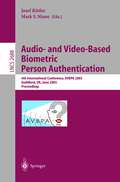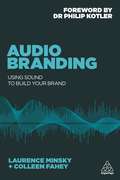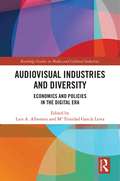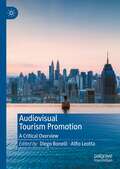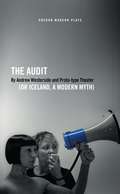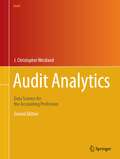- Table View
- List View
Auction Theory: Introductory Exercises with Answer Keys (Springer Texts in Business and Economics)
by Felix Munoz-Garcia Pak-Sing ChoiThis textbook provides a short introduction to auction theory through exercises with detailed answer keys. Focusing on practical examples, this textbook offers over 80 exercises that predict bidders’ equilibrium behaviour in different auction formats, along with the seller’s strategic incentives to organize one auction format over the other. The book emphasizes game-theoretic tools, so students can apply similar tools to other auction formats. Also included are several exercises based on published articles, with the model reduced to its main elements and the question divided into several easy-to-answer parts. Little mathematical background in algebra and calculus is assumed, and most algebraic steps and simplifications are provided, making the text ideal for upper undergraduate and graduate students.The book begins with a discussion of second-price auctions, which can be studied without using calculus, and works through progressively more complicated auction scenarios: first-price auctions, all-pay auctions, third-price auctions, the Revenue Equivalence principle, common-value auctions, multi-unit auctions, and procurement auctions. Exercises in each chapter are ranked according to their difficulty, with a letter (A-C) next to the exercise title, which allows students to pace their studies accordingly. The authors also offer a list of suggested exercises for each chapter, for instructors teaching at varying levels: undergraduate, Masters, Ph.D.Providing a practical, customizable approach to auction theory, this textbook is appropriate for students of economics, finance, and business administration. This book may also be used for related classes such as game theory, market design, economics of information, contract theory, or topics in microeconomics.
The Auctioneer: Adventures in the Art Trade
by Simon de PuryIn the glamorous and secretive world of art, Simon de Pury is the ultimate insider. Having elevated the auction into performance art, he is the most famous of all auctioneers. He has been chairman of the global auction house Phillips de Pury, challenging the duopoly of Sotheby's and Christie's. Before that, he was director of the Thyssen Collection, one of the world's greatest private art collections, then the chairman of Sotheby's Europe. For his style, his longevity and his unprecedented success as an auctioneer Simon has been called the Mick Jagger of the art world, but he is also a major collector and dealer in his own right, and a consultant to heads of state and heads of corporations. The Auctioneer gives us a brilliant behind-the-scenes look at the multi-billion-pound international art dealing world - where on a single night a major auction can rack up sales totalling more than £100 million; artists rub shoulders with some of the wealthiest and most powerful people on the planet; and sometimes the buyer really should beware.
Auctioning Real Property (Building and Surveying Series)
by Richard Courtenay LordConcentrating exclusively on the auctioning of real property, this book draws on a wide range of working auctioneers' experiences. All facets of the auction process are examined and explained in a logical step by step sequence.The book contains a wealth of practical advice and useful tips, together with comment on the pitfalls and problems that await the unwary. There are helpful sections giving guidance and the law on all important aspects including particulars, price guides, the reserve and bidding.
Auctions: Theory and Practice (PDF) (The Toulouse Lectures in Economics)
by Paul KlempererGovernments use them to sell everything from oilfields to pollution permits, and to privatize companies; consumers rely on them to buy baseball tickets and hotel rooms, and economic theorists employ them to explain booms and busts. Auctions make up many of the world's most important markets; and this book describes how auction theory has also become an invaluable tool for understanding economics. Auctions: Theory and Practice provides a non-technical introduction to auction theory, and emphasises its practical application. Although there are many extremely successful auction markets, there have also been some notable fiascos, and Klemperer provides many examples. He discusses the successes and failures of the one-hundred-billion dollar "third-generation" mobile-phone license auctions; he, jointly with Ken Binmore, designed the first of these. Klemperer also demonstrates the surprising power of auction theory to explain seemingly unconnected issues such as the intensity of different forms of industrial competition, the costs of litigation, and even stock trading 'frenzies' and financial crashes. Engagingly written, the book makes the subject exciting not only to economics students but to anyone interested in auctions and their role in economics.
Auctions in the Electricity Market: Bidding when Production Capacity Is Constrained (Lecture Notes in Economics and Mathematical Systems #617)
by Stefan SchöneElectricity is an essential commodity traded at power exchanges. Its price is very volatile within a day and over the year. This raises questions about the efficiency of the trading rules. The author develops a non-cooperative auction model analyzing the bidding behavior of producers at power exchanges. Producers are limited by the production capacity of their power plants. Production costs are affiliated. This allows for independence or positive correlation. The author analyzes and compares a uniform-price, a discriminatory, and a generalized second-price auction. Optimal bids, cost efficiency, profits, and consumer prices are examined. A simple probability density function of affiliated production costs is given and used for examples. Numerical results are presented. The results of the analysis can help improving the bidding strategies of producers, selecting the best auction type at power exchanges or detecting price manipulations.
Auctions, Market Mechanisms and Their Applications: Second International ICST Conference, AMMA 2011, New York, USA, August 22-23, 2011, Revised Selected Papers (Lecture Notes of the Institute for Computer Sciences, Social Informatics and Telecommunications Engineering #80)
by Peter Coles Sanmay Das Sébastien Lahaie Boleslaw SzymanskiThis book constitutes the thoroughly refereed post-conference proceedings of the Second International ICST on Auctions, Market Mechanisms and Their Applications (AMMA 2011) held in New York, USA, August 22-23, 2011. The 22 revised full papers presented were carefully selected from numerous submissions covering topics such as school choice, markets for housing, energy, and advertising, prediction markets, and the theory of market design.
Auctions, Market Mechanisms and Their Applications: First International ICST Conference, AMMA 2009, Boston, MA, USA, May 8-9, 2009, Revised Selected Papers (Lecture Notes of the Institute for Computer Sciences, Social Informatics and Telecommunications Engineering #14)
by Sanmay Das Michael Ostrovsky David Pennock Boleslaw K. SzymanskiThese proceedings present the technical contributions to the First Conference on A- tions, Market Mechanisms, and Their Applications (AMMA), held May 8-9, 2009 in Boston, Massachusetts, USA. The conference was devoted to issues that arise in all stages of deploying a market mechanism to solve a problem, including theoretical and empirical examinations. In addition to more traditional academic papers, the conf- ence placed emphasis on experiences from the real world, including case studies and new applications. The main goal of AMMA was to explore the synergy required for good mechanism design. This includes an understanding of the economic and game-theoretic issues, the ability to design protocols and algorithms for realizing desired outcomes, and the knowledge of specific institutional details that are important in practical applications. We were lucky enough to attract papers and talks from economists and computer scientists, theorists and empiricists, academics and practitioners. The program, as reflected in these proceedings, ranged from fundamental theory on auctions and m- kets to empirical design and analysis of matching mechanisms, peer-to-peer-systems, and prediction markets.
The Audacity of Help: Obama's Stimulus Plan and the Remaking of America (Bloomberg #24)
by John F. WasikThe United States confronts its greatest economic crisis since the 1930s. President Obama has taken quick and decisive action to enact an economic stimulus package strong enough to address problems of historic proportions. What does this new package mean for American families, businesses, investors, and taxpayers? The Audacity of Help unrolls the blueprints and offers insights on how the economic stimulus package—as passed by Congress and signed into law by President Obama—will affect healthcare, education, the environment, energy, taxes, and more. The book includes analysis of sectors and industries that will benefit, as well as those that will not. Wasik's conclusions are firmly grounded in a comprehensive and enlightening evaluation of the final economic package passed into law. Extensive study and interviews with experts from each economic sector support his analysis.
The Audacity of Help: Obama's Stimulus Plan and the Remaking of America (Bloomberg #24)
by John F. WasikThe United States confronts its greatest economic crisis since the 1930s. President Obama has taken quick and decisive action to enact an economic stimulus package strong enough to address problems of historic proportions. What does this new package mean for American families, businesses, investors, and taxpayers? The Audacity of Help unrolls the blueprints and offers insights on how the economic stimulus package—as passed by Congress and signed into law by President Obama—will affect healthcare, education, the environment, energy, taxes, and more. The book includes analysis of sectors and industries that will benefit, as well as those that will not. Wasik's conclusions are firmly grounded in a comprehensive and enlightening evaluation of the final economic package passed into law. Extensive study and interviews with experts from each economic sector support his analysis.
Audafest: Ergebnisse einer empirischen Erhebung zum Themenbereich “Datenschutz und Datensicherung” (Forschungsberichte des Landes Nordrhein-Westfalen #3042)
by Erwin GrochlaAudience: Marketing in the Age of Subscribers, Fans and Followers
by Jeffrey K. RohrsProprietary audience development is now a core marketing responsibility. Every company needs audiences to survive. They are where you find new customers and develop more profitable relationships. And yet, most companies today treat their email, mobile, and social media audiences like afterthoughts instead of the corporate assets they are. With AUDIENCE, Jeff Rohrs seeks to change this dynamic through adoption of The Audience Imperative. This powerful mandate challenges all companies to use their paid, owned, and earned media to not only sell in the short-term but also increase the size, engagement, and value of their proprietary audiences over the long-term. As content marketing professionals have discovered, the days of “build it and they will come” are long gone. If you’re looking for a way to gain a lasting advantage over your competition, look no further and start building your email, Facebook, Google, Instagram, mobile app, SMS, Twitter, website, and YouTube audiences to last.
Audience: Marketing in the Age of Subscribers, Fans and Followers
by Jeffrey K. RohrsProprietary audience development is now a core marketing responsibility. Every company needs audiences to survive. They are where you find new customers and develop more profitable relationships. And yet, most companies today treat their email, mobile, and social media audiences like afterthoughts instead of the corporate assets they are. With AUDIENCE, Jeff Rohrs seeks to change this dynamic through adoption of The Audience Imperative. This powerful mandate challenges all companies to use their paid, owned, and earned media to not only sell in the short-term but also increase the size, engagement, and value of their proprietary audiences over the long-term. As content marketing professionals have discovered, the days of “build it and they will come” are long gone. If you’re looking for a way to gain a lasting advantage over your competition, look no further and start building your email, Facebook, Google, Instagram, mobile app, SMS, Twitter, website, and YouTube audiences to last.
Audience Development and Cultural Policy (New Directions in Cultural Policy Research)
by Steven HadleyEncouraging more – and different – people to attend the arts remains a vital issue for the cultural sector. The question of who consumes culture, and why, is key to our understanding of the arts. This book examines the relationship of audience development to cultural policy and offers a ground-breaking perspective on how the practice of audience development is connected to ideas of democratic access to culture. Providing a detailed overview of arts marketing, audience development and cultural democracy, the book argues that the work of audience development has been profoundly misunderstood by the field of arts management. Drawing from a rich range of interviews with key individuals in the audience development field, the book argues for a re-conceptualisation of audience development as an ideological function of cultural policy. Of importance for students, academics and researchers working in arts management and cultural policy, the book is also vital reading for anyone working in the arts, cultural and heritage sectors with an interest in understanding how our relationship with the audience has been constructed.
Audience Development in der Migrationsgesellschaft: Neue Strategien für Kulturinstitutionen (Schriften zum Kultur- und Museumsmanagement)
by Vera AllmanritterDeutschland ist ein Einwanderungsland - dies stellt auch Kulturinstitutionen vor die Frage, wie sie Menschen mit Migrationshintergrund für ihre Angebote begeistern und somit zu deren kultureller Teilhabe beitragen können. Was aber sind deren kulturelle Interessen, wodurch zeichnet sich ihr Kulturnutzungsverhalten aus und was sind etwaige Besuchsbarrieren? Vera Allmanritter geht in einer empirischen Studie diesen Fragen nach, liefert einen Überblick über den aktuellen Forschungsstand und stellt praxisnah dar, wie Kulturinstitutionen Audience Development für Menschen unterschiedlicher Milieus und Herkunft betreiben können.
Audio- and Video-Based Biometric Person Authentication: Third International Conference, AVBPA 2001 Halmstad, Sweden, June 6-8, 2001. Proceedings (Lecture Notes in Computer Science #2091)
by Josef Bigun Fabrizio SmeraldiAudio- and Video-Based Biometric Person Authentication: 5th International Conference, AVBPA 2005, Hilton Rye Town, NY, USA, July 20-22, 2005, Proceedings (Lecture Notes in Computer Science #3546)
by Takeo Kanade Anil Jain Nalini K. RathaThis book constitutes the refereed proceedings of the 5th International Conference on Audio- and Video-Based Biometric Person Authentication, AVBPA 2005, held in Hilton Rye Town, NY, USA, in July 2005. The 66 revised oral papers and 50 revised poster papers presented were carefully reviewed and selected from numerous submissions. The papers discuss all aspects of biometrics including iris, fingerprint, face, palm print, gait, gesture, speaker, and signature; theoretical and algorithmic issues are dealt with as well as systems issues. The industrial side of biometrics is evident from presentations on smart cards, wireless devices, and architectural and implementation aspects.
Audio-and Video-Based Biometric Person Authentication: 4th International Conference, AVBPA 2003, Guildford, UK, June 9-11, 2003, Proceedings (Lecture Notes in Computer Science #2688)
by Josef Kittler Mark S. NixonThe refereed proceedings of the 4th International Conference on Audio-and Video-Based Biometric Person Authentication, AVBPA 2003, held in Guildford, UK, in June 2003. The 39 revised full plenary papers and 72 revised full poster papers were carefully reviewed and selected for presentation. There are topical sections on face; speech; fingerprint; image, video processing, and tracking; general issues; handwriting, signature, and palm; gait; and fusion.
Audio Branding: Using Sound to Build Your Brand
by Laurence Minsky Colleen FaheyAudio Branding is a concise, practical guide on the influential world of audio branding - what it is, why it's important, and how it can be used to enhance a brand. Consider the familiar tune of a branded ringtone, the bubbly sounds of Skype, and even the chosen sound bite for a branded car unlocking as the driver presses the key. How do these choices tie into a wider brand identity? Which emotions do they spark, and most importantly, how do these choices enhance brand association with the consumer?Audio Branding delivers fascinating insights into this area of marketing, underpinned by practical step-by-step guidance and cutting-edge research to enhance brand loyalty through user experience. Written by authors who have contributed directly to the development of this field, the book contains an enlightening set of case studies, including companies such as Renault (a surprisingly emotional audio brand) Atlanta Convention & Visitors Bureau (a warm, energetic audio brand), and Michelin (a globally coherent audio brand). Covering issues such as the dominance of audio-enabled devices and the phenomenon of continuous partial attention, Audio Branding demonstrates how brands can infuse sound into so many different aspects of their identity, building in a subtle longevity of brand presence through daily user experience.
Audio Branding: Using Sound to Build Your Brand
by Laurence Minsky Colleen FaheyAudio Branding is a concise, practical guide on the influential world of audio branding - what it is, why it's important, and how it can be used to enhance a brand. Consider the familiar tune of a branded ringtone, the bubbly sounds of Skype, and even the chosen sound bite for a branded car unlocking as the driver presses the key. How do these choices tie into a wider brand identity? Which emotions do they spark, and most importantly, how do these choices enhance brand association with the consumer?Audio Branding delivers fascinating insights into this area of marketing, underpinned by practical step-by-step guidance and cutting-edge research to enhance brand loyalty through user experience. Written by authors who have contributed directly to the development of this field, the book contains an enlightening set of case studies, including companies such as Renault (a surprisingly emotional audio brand) Atlanta Convention & Visitors Bureau (a warm, energetic audio brand), and Michelin (a globally coherent audio brand). Covering issues such as the dominance of audio-enabled devices and the phenomenon of continuous partial attention, Audio Branding demonstrates how brands can infuse sound into so many different aspects of their identity, building in a subtle longevity of brand presence through daily user experience.
Audio-Visual Industries and Diversity: Economics and Policies in the Digital Era (Routledge Studies in Media and Cultural Industries)
by Luis A. Albornoz Mª Trinidad García LeivaThis book reflects critically on issues of diversity, access, and the expansion of digital technologies in audio-visual industries, particularly in terms of economics and policies. It brings together specialists in cultural diversity and media industries, presenting an international and interdisciplinary collection of essays that draw from different fields of studies – notably Communication, Economics, Political Science and Law. Among the topics discussed are: the principle of diversity as a goal of cultural and communication policies, the assessment of the UNESCO Convention on Cultural Diversity, free trade agreements and the conception of cultural goods and services they advance, the challenges faced by the production, circulation and consumption of cultural content through the Internet, the role algorithms play in the organization and functioning of online platforms, Netflix and the hegemony of global media. The approach is a critical understanding of audio-visual diversity, that aims to transcend specific issues like media ownership, ideas portrayed or modes of consumption as such, to focus on a more balanced distribution of communicative power. This volume is an essential read for scholars and researchers in Communication Studies, Economy of Culture, International Relations and International Law, as well as policy makers, journalists specialized in media and culture, and managers of public and private institutions involved in the development of cultural and communication policies. Postgraduate students will find it a key reference point.
Audio-Visual Industries and Diversity: Economics and Policies in the Digital Era (Routledge Studies in Media and Cultural Industries)
by Luis A. Albornoz Ma. Trinidad García LeivaThis book reflects critically on issues of diversity, access, and the expansion of digital technologies in audio-visual industries, particularly in terms of economics and policies. It brings together specialists in cultural diversity and media industries, presenting an international and interdisciplinary collection of essays that draw from different fields of studies – notably Communication, Economics, Political Science and Law. Among the topics discussed are: the principle of diversity as a goal of cultural and communication policies, the assessment of the UNESCO Convention on Cultural Diversity, free trade agreements and the conception of cultural goods and services they advance, the challenges faced by the production, circulation and consumption of cultural content through the Internet, the role algorithms play in the organization and functioning of online platforms, Netflix and the hegemony of global media. The approach is a critical understanding of audio-visual diversity, that aims to transcend specific issues like media ownership, ideas portrayed or modes of consumption as such, to focus on a more balanced distribution of communicative power. This volume is an essential read for scholars and researchers in Communication Studies, Economy of Culture, International Relations and International Law, as well as policy makers, journalists specialized in media and culture, and managers of public and private institutions involved in the development of cultural and communication policies. Postgraduate students will find it a key reference point.
Audiovisual Tourism Promotion: A Critical Overview
by Alfio Leotta Diego BonelliThis book deploys the concept of ‘audiovisual tourism promotion’ to account for the promotional functions performed by a vast array of diverse media texts including tourism films, feature films, digital videos conceived for online circulation, video games and TV commercials. From this point of view, this volume fills a major gap in the literature by providing the first comprehensive critical overview of audiovisual tourism promotion as a distinct media field. In this book, the study of audiovisual tourism promotion is characterised by an interdisciplinary approach which combines film studies, media studies, human geography, sociology, tourism studies, history, postcolonial and gender studies. This book will appeal to a wide range of students and scholars from different disciplines.
The Audit (Oberon Modern Plays)
by Andrew Westerside Proto-Type TheaterThere’s a shadow coming, across the sea. Long and terrifying. The vultures are circling, the wolves are howling… how can we weather this storm?The global economy is a mess. The crash has landed, the tide’s swept out, and it’s taken our hope with it. There’s less in our pockets and more to be spent. The rich have got richer, the middle’s squeezed tight, and the poor are being dragged ever downwards.With the true value of money and the human cost of greed firmly in their sights, Proto-type Theater tell the story of how, in the aftermath of the 2008 economic crash, the nation of Iceland raised their voices in protest and railed against the currents.Using original text, performance, film, music and animation, The Audit is about finding strength, overcoming a world designed to keep us docile, and how collective power can move a mountain – even if only a little.
Audit Analytics: Data Science for the Accounting Profession (Use R!)
by J. Christopher WestlandToday, information technology plays a pivotal role in financial control and audit: most financial data is now digitally recorded and dispersed among servers, clouds and networks over which the audited firm has no control. Additionally, a firm’s data—particularly in the case of finance, software, insurance and biotech firms— comprises most of the audited value of the firm. Financial audits are critical mechanisms for ensuring the integrity of information systems and the reporting of organizational finances. They help avoid the abuses that led to passage of legislation such as the Foreign Corrupt Practices Act (1977), and the Sarbanes-Oxley Act (2002). Audit effectiveness has declined over the past two decades as auditor skillsets have failed to keep up with advances in information technology. Information and communication technology lie at the core of commerce today and are integrated in business processes around the world. This book is designed to meet the increasing need of audit professionals to understand information technology and the controls required to manage it. The material included focuses on the requirements for annual Securities and Exchange Commission audits (10-K) for listed corporations. These represent the benchmark auditing procedures for specialized audits, such as internal, governmental, and attestation audits.Using R and RStudio, the book demonstrates how to render an audit opinion that is legally and statistically defensible; analyze, extract, and manipulate accounting data; build a risk assessment matrix to inform the conduct of a cost-effective audit program; and more.
Audit Analytics: Data Science for the Accounting Profession (Use R!)
by J. Christopher WestlandThis book, using R and RStudio, demonstrates how to render an audit opinion that is legally and statistically defensible; analyze, extract, and manipulate accounting data; build a risk assessment matrix to inform the conduct of a cost-effective audit program; and more. Today, information technology plays a pivotal role in financial control and audit: most financial data is now digitally recorded and dispersed among servers, clouds and networks over which the audited firm has no control. Additionally, a firm’s data—particularly in the case of finance, software, insurance and biotech firms—comprises most of the audited value of the firm. Financial audits are critical mechanisms for ensuring the integrity of information systems and the reporting of organizational finances. They help avoid the abuses that led to passage of legislation such as the Foreign Corrupt Practices Act (1977), and the Sarbanes-Oxley Act (2002). Audit effectiveness has declined over the past two decades, as auditor skillsets have failed to keep up with advances in information technology. Information and communication technology lie at the core of commerce today and are integrated in business processes around the world. This book is designed to meet the increasing need of audit professionals to understand information technology and the controls required to manage it. This 2nd edition includes updated code and test. Machine learning, AI, and SEC’s EDGAR data are also, improved and updated. The material included focuses on the requirements for annual Securities and Exchange Commission audits (10-K) for listed corporations. These represent the benchmark auditing procedures for specialized audits, such as internal, governmental, and attestation audits. Many examples reflect the focus of the 2024 CPA exam, and the data analytics-machine learning approach will be central to the AICPA’s programs, in the near future.
